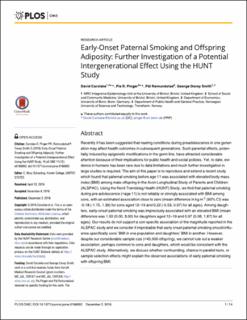| dc.contributor.author | Carslake, David | |
| dc.contributor.author | Pinger, Pia R | |
| dc.contributor.author | Romundstad, Pål Richard | |
| dc.contributor.author | Smith, George Davey | |
| dc.date.accessioned | 2020-04-17T06:15:20Z | |
| dc.date.available | 2020-04-17T06:15:20Z | |
| dc.date.created | 2017-01-17T12:54:11Z | |
| dc.date.issued | 2016 | |
| dc.identifier.citation | PLOS ONE. 2016, 11 (12), . | en_US |
| dc.identifier.issn | 1932-6203 | |
| dc.identifier.uri | https://hdl.handle.net/11250/2651385 | |
| dc.description.abstract | Recently it has been suggested that rearing conditions during preadolescence in one generation may affect health outcomes in subsequent generations. Such parental effects, potentially induced by epigenetic modifications in the germ line, have attracted considerable attention because of their implications for public health and social policies. Yet, to date, evidence in humans has been rare due to data limitations and much further investigation in large studies is required. The aim of this paper is to reproduce and extend a recent study which found that paternal smoking before age 11 was associated with elevated body mass index (BMI) among male offspring in the Avon Longitudinal Study of Parents and Children (ALSPAC). Using the Nord-Trøndelag Health (HUNT) Study, we find that paternal smoking during pre-adolescence (<age 11) is not reliably or strongly associated with BMI among sons, with an estimated association close to zero (mean difference in kg m-2 (95% CI) was -0.18 (-1.75, 1.39) for sons aged 12–19 and 0.22 (-0.53, 0.97) for all ages). Among daughters, early-onset paternal smoking was imprecisely associated with an elevated BMI (mean difference was 1.50 (0.00, 3.00) for daughters aged 12–19 and 0.97 (0.06, 1.87) for all ages). Our results do not support a son-specific association of the magnitude reported in the ALSPAC study and we consider it improbable that early onset paternal smoking should influence specifically sons' BMI in one population and daughters' BMI in another. However, despite our considerable sample size (>45,000 offspring), we cannot rule out a weaker association, perhaps common to sons and daughters, which would be consistent with the ALSPAC study. Alternatively, we discuss whether confounding, chance in parallel tests, or sample selection effects might explain the observed associations of early paternal smoking with offspring BMI. | en_US |
| dc.language.iso | eng | en_US |
| dc.publisher | PLOS, Public Library of Science | en_US |
| dc.rights | Navngivelse 4.0 Internasjonal | * |
| dc.rights.uri | http://creativecommons.org/licenses/by/4.0/deed.no | * |
| dc.title | Early-Onset paternal smoking and offspring adiposity: Further investigation of a potential intergenerational effect using the HUNT study | en_US |
| dc.type | Peer reviewed | en_US |
| dc.type | Journal article | en_US |
| dc.description.version | publishedVersion | en_US |
| dc.source.pagenumber | 14 | en_US |
| dc.source.volume | 11 | en_US |
| dc.source.journal | PLOS ONE | en_US |
| dc.source.issue | 12 | en_US |
| dc.identifier.doi | 10.1371/journal.pone.0166952 | |
| dc.identifier.cristin | 1429666 | |
| dc.description.localcode | Copyright: © 2016 Carslake et al. This is an open access article distributed under the terms of the Creative Commons Attribution License, which permits unrestricted use, distribution, and reproduction in any medium, provided the original author and source are credited. | en_US |
| cristin.ispublished | true | |
| cristin.fulltext | original | |
| cristin.qualitycode | 1 | |

